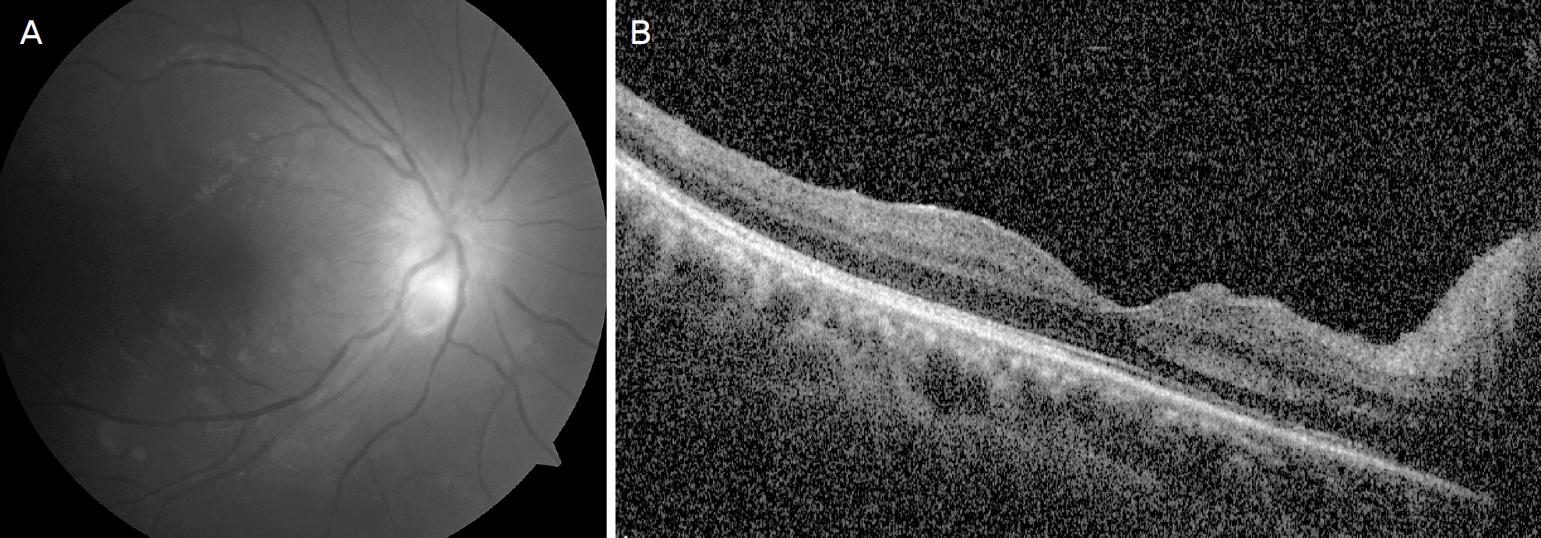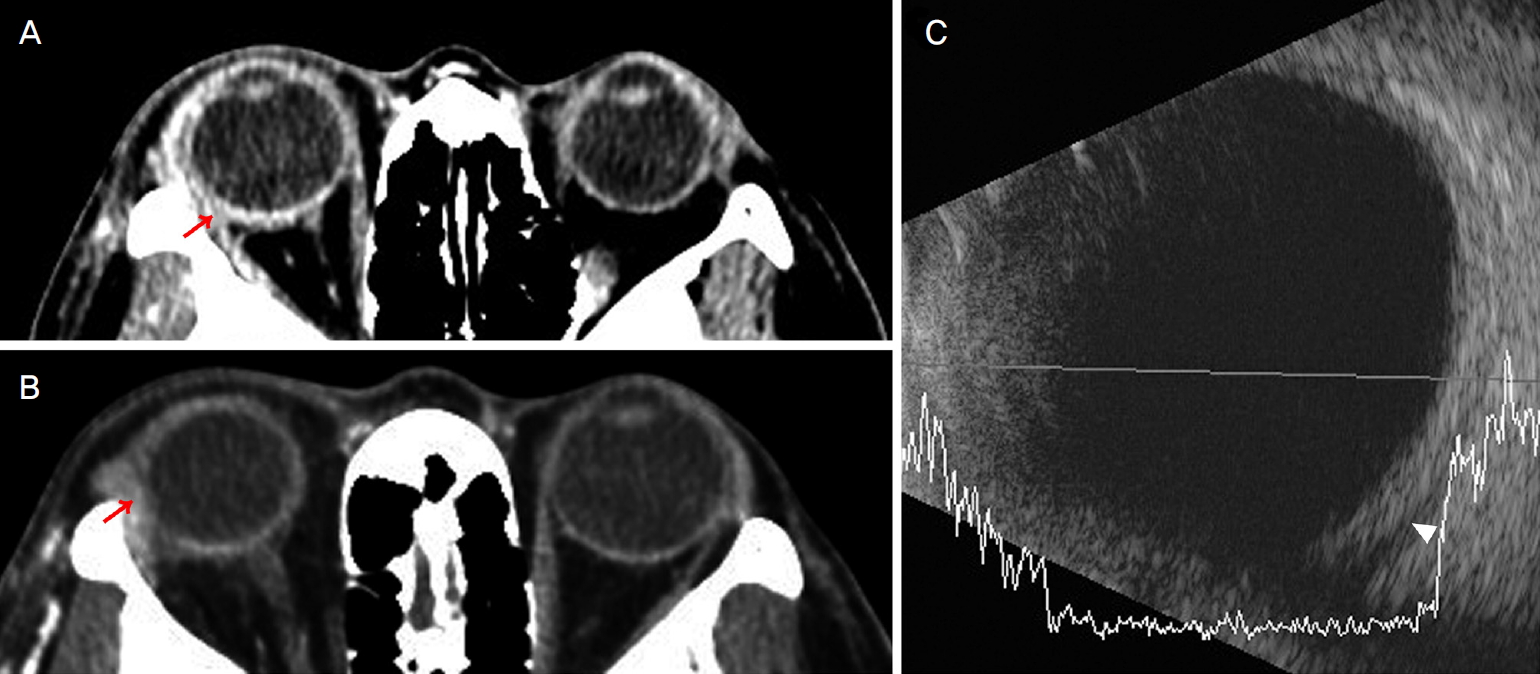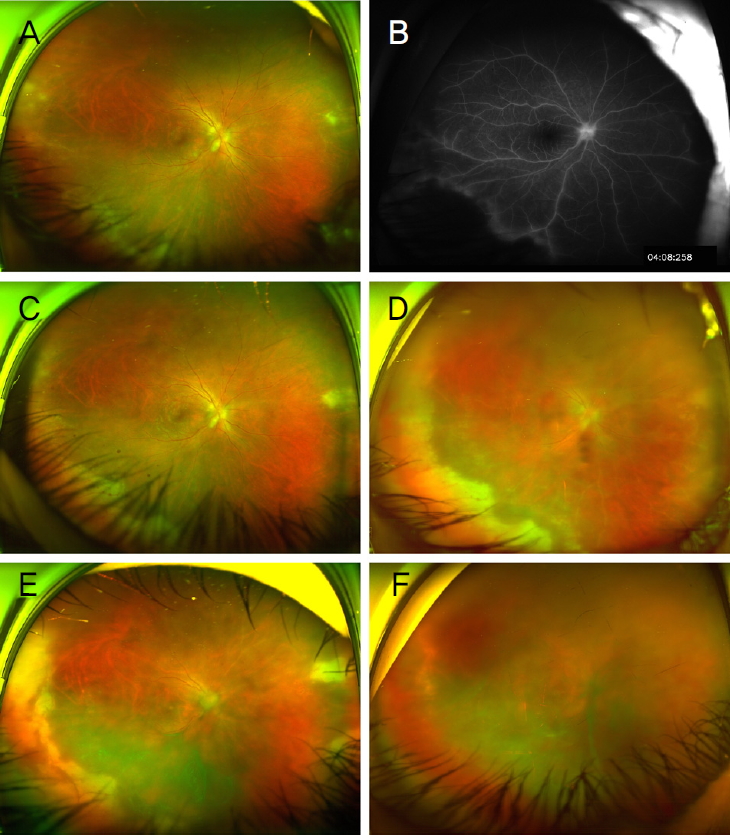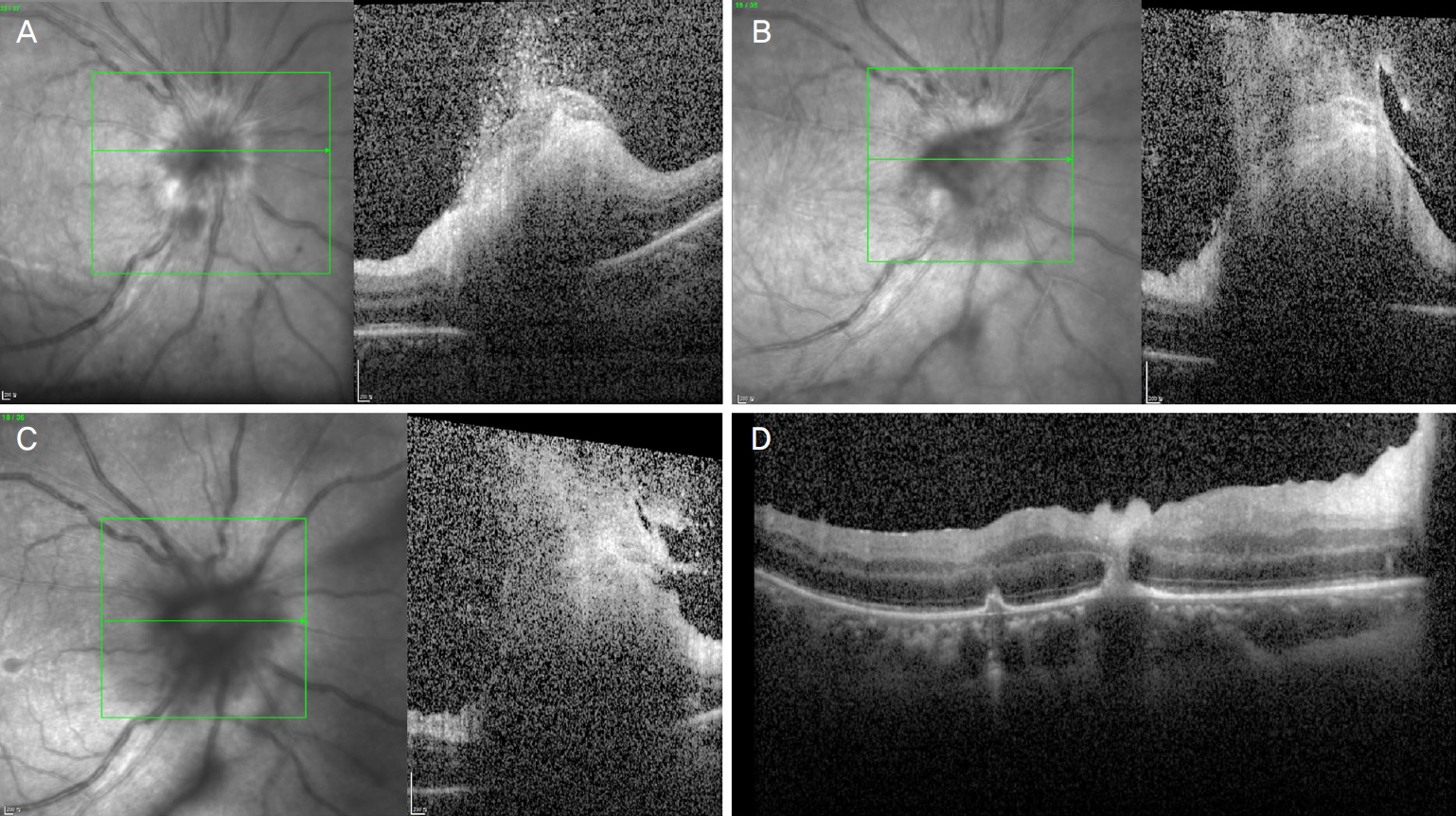 |
 |
| J Korean Ophthalmol Soc > Volume 61(8); 2020 > Article |
|
ĻĄŁļ¼Ėņ┤łļĪØ
ļ¬®ņĀü
ņĢłņÖĆņŚ╝ņ”Ø ņ”Øņāüņ£╝ļĪ£ ļé┤ņøÉĒĢśņŚ¼ ĻĖēņä▒ļ¦Øļ¦ēĻ┤┤ņé¼ļĪ£ ņ¦äļŗ©ļÉ£ ņé¼ļĪĆļź╝ Ļ▓ĮĒŚśĒĢśņśĆĻĖ░ņŚÉ ņØ┤ļź╝ ļ│┤Ļ│ĀĒĢśĻ│Āņ×É ĒĢ£ļŗż.
ņ”ØļĪĆņÜöņĢĮ
33ņäĖ ņŚ¼ņ×É ĒÖśņ×ÉĻ░Ć ņÜ░ņĢł ņČ®Ēśł, Ļ▓░ļ¦ēļČĆņóģ ļ░Å ĒåĄņ”ØņØä ņŻ╝ņåīļĪ£ ļ│ĖņøÉ ļé┤ņøÉĒĢśņśĆļŗż. ļé┤ņøÉ ļŗ╣ņŗ£ ņÜ░ņĢł ļéśņĢłņŗ£ļĀź 1.0, ņĀäļ░® ļé┤ ņŚ╝ņ”ØņäĖĒżļŖö 2+ļĪ£ Ļ┤Ćņ░░ļÉśņŚłņ£╝ļ®░, ĒżļÅäļ¦ēņŚ╝ ļ░Å ņĢłņÖĆņŚ╝ņ”ØņØä ļÅÖļ░śĒĢ£ ĒøäĻ│Ąļ¦ēņŚ╝ ņåīĻ▓¼ņ£╝ļĪ£ Ļ│ĀņÜ®ļ¤ē ņŖżĒģīļĪ£ņØ┤ļō£ ņĀĢļ¦źņŻ╝ņé¼ļź╝ ņŗ£Ē¢ēĒĢśņśĆļŗż. ņØ┤Ēøä ņŻ╝ļ│ĆļČĆ ļ¦Øļ¦ēĻ┤┤ņé¼ņÖĆ ĒÅÉņćäĒśłĻ┤ĆņŚ╝ņØ┤ Ļ┤Ćņ░░ļÉśļ®┤ņä£ ĻĖēņä▒ļ¦Øļ¦ēĻ┤┤ņé¼ļĪ£ ĒīÉļŗ©ĒĢśĻ│Ā, acyclovir ņĀĢļ¦źņŻ╝ņé¼ļź╝ ĒżĒĢ©ĒĢ£ foscarnet ņ£Āļ”¼ņ▓┤Ļ░Ģļé┤ ņŻ╝ņé¼, ņןļ▓ĮļĀłņØ┤ņĀĆņłĀņØä ņŗ£Ē¢ēĒĢśņśĆĻ│Ā, Ēć┤ņøÉ ĒøäņŚÉļÅä valacyclovir ļ│ĄņÜ®ĒĢśļ®┤ņä£ Ļ▓ĮĻ│╝ Ļ┤Ćņ░░ĒĢśņśĆļŗż. ņ╣śļŻī 3ļŗ¼ņ¦Ė, ņÜ░ņĢłņØś ņ£Āļ”¼ņ▓┤Ēś╝Ēāü, ļ¦īņä▒ ņŗ£ņŗĀĻ▓ĮļČĆņóģ ļ░Å ĒŚłĒśłņä▒ ļ│ĆĒÖö, ĒÖ®ļ░śļČĆņØś ļ│Ćņä▒ ļ░Å ļ¦īņä▒ ļČĆņóģņ£╝ļĪ£ ņÜ░ņĢł ņŗ£ļĀźņØĆ ņĢłņĀä ņłśļÅÖņØ┤ļéś, ņ¢æņĢł ņāłļĪ£ņÜ┤ ļ│æļ│ĆņØś ļ░£ņāØ ņŚåņØ┤ ņĢłņĀĢņĀüņ£╝ļĪ£ ņ£Āņ¦ĆļÉśĻ│Ā ņ׳ļŗż.
ABSTRACT
Purpose
To describe a case of acute retinal necrosis with clinical features of orbital inflammation.
Case summary
A 33-year-old female presented with right eye injection, chemosis, and pain. At the first visit, the uncorrected visual acuity and intraocular pressure of her right eye were 20/20 and 20 mmHg, respectively. Slit-lamp examination showed inflammatory cell 2+ in the anterior chamber of the right eye; an evaluation of the peripheral retina was not conducted. The next day, computed tomography (CT) was performed due to aggravation of the orbital inflammation. High-dose intravenous methylprednisolone injection was initiated on the finding of posterior scleritis with orbital inflammation on CT scans; peripheral retinal necrosis and obstructive vasculitis were also noted. Clinically determined to be acute retinal necrosis, the patient began systemic antiviral therapy. A diagnostic anterior chamber paracentesis was positive for herpes simplex virus type 2 by polymerase chain reaction. The patient was treated with intravenous acyclovir and intravitreal injections of foscarnet, as well as barrier laser therapy. After two weeks of treatment, the patient was discharged with oral valacyclovir. During the three months of follow-up, the visual acuity of the right eye was hand motion, due to chronic optic disc swelling with chronic macular edema and macular degeneration. Neither eye showed retinal lesion progression.
1971ļģä Urayama [1]ņŚÉ ņØśĒĢ┤ ņ▓śņØī ĻĖēņä▒ļ¦Øļ¦ēĻ┤┤ņé¼ļØ╝ļŖö ņ¦łĒÖśņØ┤ ļ│┤Ļ│ĀļÉśņŚłņ£╝ļ®░, Ēśäņ×¼ ĻĖēņä▒ļ¦Øļ¦ēĻ┤┤ņé¼ļŖö ņĢłĻĄ¼ļé┤ ņŚ╝ņ”Øņ¦łĒÖśņ£╝ļĪ£, ĒĢŁļ░öņØ┤ļ¤¼ņŖż ņ╣śļŻīļź╝ ņŗ£Ē¢ēĒĢśņ¦Ć ņĢŖņØä Ļ▓ĮņÜ░ ļ╣Āļź┤Ļ▓ī ņ¦äĒ¢ēĒĢśļŖö ņŻ╝ļ│ĆļČĆ ļ¦Øļ¦ēĻ┤┤ņé¼ņÖĆ ĒÅÉņćäĒśłĻ┤Ćļ│æņ”Ø, ņĀäļ░® ļśÉļŖö ņ£Āļ”¼ņ▓┤ņØś ņŚ╝ņ”ØņØä ļÅÖļ░śĒĢśļŖö ņ¦łĒÖśņØ┤ļŗż. ĻĖēņä▒ļ¦Øļ¦ēĻ┤┤ņé¼ņØś ņøÉņØĖņ£╝ļĪ£ļŖö ņłśļæÉļīĆņāüĒżņ¦äļ░öņØ┤ļ¤¼ņŖż(varicella zoster virus)Ļ░Ć Ļ░Ćņן ļ¦ÄņØĆ ļ╣äņ£©ņØä ņ░©ņ¦ĆĒĢśļ®░, ļŗ©ņł£Ēżņ¦äļ░öņØ┤ļ¤¼ņŖż 1ĒśĢ(Herpes simplex virus type I, HSV-1)Ļ│╝ 2ĒśĢ(HSV-2)ņØ┤ ĻĘĖ ļŗżņØīņØä ņ░©ņ¦ĆĒĢ£ļŗż[2]. ĻĖēņä▒ļ¦Øļ¦ēĻ┤┤ņé¼ņØś ņ╣śļŻī ļ░®ļ▓Ģņ£╝ļĪ£ļŖö ĒĢŁļ░öņØ┤ļ¤¼ņŖżņĀ£ ņĀĢļ¦źņŻ╝ņé¼, ĒĢäņÜö ņŗ£ ņ£Āļ”¼ņ▓┤Ļ░Ģļé┤ ĒĢŁļ░öņØ┤ļ¤¼ņŖżņĀ£ ņŻ╝ņé¼, ņןļ▓ĮļĀłņØ┤ņĀĆņłĀ, ļ¦Øļ¦ēļ░Ģļ”¼Ļ░Ć ļ░£ņāØĒĢ£ Ļ▓ĮņÜ░ ņłśņłĀ ņ╣śļŻīļź╝ ņŗ£Ē¢ēĒĢ£ļŗż[3]. ĒĢŁļ░öņØ┤ļ¤¼ņŖż ņ╣śļŻīļź╝ ņŗ£Ē¢ēĒĢśņ¦Ć ņĢŖņØä Ļ▓ĮņÜ░ ļ│æļ│ĆņØ┤ ĻĖēņåŹļÅäļĪ£ ņ¦äĒ¢ēĒĢ┤ ņŗ£ļĀźņśłĒøäĻ░Ć ļ¦żņÜ░ ņóŗņ¦Ć ņĢŖņ£╝ļ®░, ņ¢æņĢłņ£╝ļĪ£ ņ╣©ļ▓öĒĢĀ Ļ░ĆļŖźņä▒ņØ┤ ņ׳ņ¢┤ ņĀĢĒÖĢĒĢśĻ│Ā ļ╣ĀļźĖ ņ¦äļŗ©Ļ│╝ ņ╣śļŻīĻ░Ć ĒĢäņÜöĒĢśļŗż.
ĻĖēņä▒ļ¦Øļ¦ēĻ┤┤ņé¼ ĒÖśņ×ÉņØś ļīĆļČĆļČäņØĆ ĒżļÅäļ¦ēņØś ņŚ╝ņ”ØņØä ļÅÖļ░śĒĢśņ¦Ćļ¦ī, ņĢłņÖĆņŚ╝ņ”ØņØś ņ”ØņāüņØä ļÅÖļ░śĒĢ£ ĻĖēņä▒ļ¦Øļ¦ēĻ┤┤ņé¼ņØś ņ”ØļĪĆļŖö ĻĄŁļé┤ņŚÉ ņĢäņ¦ü ļ│┤Ļ│ĀļÉ£ ļ░ö ņŚåņ£╝ļ®░, ĒĢ┤ņÖĖņŚÉņä£ ļō£ļ¼╝Ļ▓ī ļ│┤Ļ│ĀļÉśĻ│Ā ņ׳ļŗż. ļ│Ė ļģ╝ļ¼ĖņŚÉņä£ ņĀ£ņŗ£ļÉ£ ņé¼ļĪĆļŖö 33ņäĖ ņŚ¼ņä▒ņ£╝ļĪ£, ĻĖēņä▒ļ¦Øļ¦ēĻ┤┤ņé¼ņÖĆ ņĢłņÖĆņŚ╝ņ”ØņØ┤ ĒĢ©Ļ╗ś ļÅÖļ░śļÉ£, ņĢäņ¦üĻ╣īņ¦Ć ĻĄŁļé┤ņŚÉņä£ļŖö ļ│┤Ļ│ĀļÉ£ ņĀüņØ┤ ņŚåļŖö ļō£ļ¼Ė ņ×äņāü Ļ▓ĮĻ│╝ļź╝ ļ│┤ņŚ¼ ņØ┤ļź╝ ļ│┤Ļ│ĀĒĢśĻ│Āņ×É ĒĢ£ļŗż.
33ņäĖ ņŚ¼ņ×ÉĻ░Ć ļé┤ņøÉ 3ņØ╝ ņĀäļČĆĒä░ ņÜ░ņĢł ņČ®Ēśł, Ļ▓░ļ¦ēļČĆņóģ ļ░Å ĒåĄņ”ØņØä ņŻ╝ņåīļĪ£ ļ│ĖņøÉ ļé┤ņøÉĒĢśņśĆļŗż. 5ļģä ņĀä ņ¢æņĢł ļØ╝ņŗØņłśņłĀ Ļ│╝Ļ▒░ļĀź ņÖĖ ņĀäņŗĀņ¦łĒÖś ļ░Å ņłśņłĀļĀźņØĆ ņŚåņŚłļŗż. ļ│ĖņøÉ ņ┤łņ¦ä ļŗ╣ņŗ£ ļéśņĢłņŗ£ļĀź ņÜ░ņĢł 1.0, ņóīņĢł 1.0ņØ┤ņŚłņ£╝ļ®░, ņĢłņĢĢņØĆ ņÜ░ņĢł 20 mmHg, ņóīņĢł 10 mmHgņśĆļŗż. ņäĖĻĘ╣ļō▒Ēśäļ»ĖĻ▓ĮĻ▓Ćņé¼ņāü ņÜ░ņĢł Ļ▓░ļ¦ēļČĆņóģĻ│╝ ņČ®Ēśł, Standardization of Uveitis Nomenclature ĻĖ░ņżĆņ£╝ļĪ£ ņĀäļ░® ļé┤ ņŚ╝ņ”ØņäĖĒżĻ░Ć 2+ļĪ£ Ļ┤Ćņ░░ļÉśņŚłļŗż. ņĢłņĀĆĻ▓Ćņé¼ņāü ņÜ░ņĢł ņŗ£ņŗĀĻ▓Įņ£ĀļæÉļČĆņóģ ņåīĻ▓¼ ļ░Å ņ£Āļ”¼ņ▓┤ ļé┤ ņŚ╝ņ”ØņäĖĒż ņåīĻ▓¼ņØ┤ ņ׳ņŚłņ£╝ļéś ļ╣øĻ░äņäŁļŗ©ņĖĄņ┤¼ņśü(optical coherence tomography)ņŚÉņä£ ĒÖ®ļ░śļČĆ ņ╣©ļ▓ö ļ░Å, ĒśłĻ┤ĆņŚ╝ņØĆ ļ░£Ļ▓¼ļÉśņ¦Ć ņĢŖņĢśļŗż(Fig. 1). ņé░ļÅÖ Ēøä ņŻ╝ļ│ĆļČĆ ļ¦Øļ¦ēņŚÉ ļīĆĒĢ£ ĒÅēĻ░ĆļŖö ņØ┤ļŻ©ņ¢┤ņ¦Ćņ¦Ć ņĢŖņĢśņ£╝ļ®░, ĒżļÅäļ¦ēņŚ╝ Ļ░ĆļŖźņä▒ĒĢś 1.5% levofloxacin (Cravit┬«, Santen Pharmaceutical Co., Ltd., Osaka, Japan), 0.5% loteprednol etabonate (Lotemax┬«, Bausch & Lomb, Tampa, FL, USA)ņØä Ļ░üĻ░ü ĒĢśļŻ© 4ļ▓łņö® ņĀÉņĢłĒĢśĻ▓ī ĒĢśņśĆļŗż. ņ╣śļŻī ņŗ£Ē¢ē ļŗżņØīļéĀ ĒÖśņ×ÉļŖö ņŗ£ļĀźņĀĆĒĢś ļ░Å ļłłĻ║╝ĒÆĆļČĆņóģņØä ĒśĖņåīĒĢśņŚ¼ ņ×¼ļé┤ņøÉĒĢśņśĆļŗż. ņÜ░ņĢł ņŗ£ļĀź 0.7ļĪ£ Ļ░ÉņåīĒĢśņśĆņ£╝ļ®░, ņÜ░ņĢł ņĢłĻĄ¼ļÅīņČ£ 0.5 mm ļ░Å ņÜ░ņĢł ļé┤ņĀäĻ│╝ ņāüĒĢśņĀäņØś ņĀ£ĒĢ£ņØ┤ ļ░£ņāØĒĢśņśĆļŗż(Fig. 2A). ļśÉĒĢ£, Ļ░üļ¦ē Ēøäļ®┤ ņ╣©ņ░®ļ¼╝ņØ┤ ĒÖĢņØĖļÉśņŚłņ£╝ļ®░, ņĀäļ░® ļé┤ ņŚ╝ņ”ØņäĖĒżļŖö 4+ļĪ£ ņ”ØĻ░ĆĒĢ£ ņåīĻ▓¼ņØ┤ņŚłļŗż. ņĢłņÖĆņŚ╝ņ”ØņØś Ļ░Éļ│äņØä ņ£äĒĢ┤ ņĀäņé░ĒÖöļŗ©ņĖĄņ┤¼ņśü(computed tomography, CT) ņ┤¼ņśü ļ░Å ĒśłņĢĪĻ▓Ćņé¼ļź╝ ņŗ£Ē¢ēĒĢśņśĆļŗż. CTņāüņŚÉņä£ ņÜ░ņĢł ĒøäĻ│Ąļ¦ēņØś ņĪ░ņśüņ”ØĻ░ĢņØ┤ ĒÖĢņØĖļÉśņŚłņ£╝ļ®░(Fig. 3A), ņ┤łņØīĒīīĻ▓Ć ņé¼ņāüņŚÉņä£ļÅä ĒøäĻ│Ąļ¦ēņØ┤ ļæÉĻ║╝ņøīņ¦ä Ļ▓āņØä ĒÖĢņØĖĒĢĀ ņłś ņ׳ņŚłļŗż(Fig. 3B). CT ņ┤¼ņśü Ēøä, ņä▒ĒśĢņĢłĻ│╝ņÖĆ ņŗĀĻ▓ĮņĢłĻ│╝ Ēśæņ¦äņØä ņ¦äĒ¢ēĒĢśņśĆņ£╝ļ®░, ņĢłņÖĆņŚ╝ņ”ØņØä ļÅÖļ░śĒĢ£ 2ņ░©ņä▒ ĒøäĻ│Ąļ¦ēņŚ╝, ĒżļÅäļ¦ēņŚ╝ ņØśņŗ¼ ņåīĻ▓¼ņ£╝ļĪ£ ņ×ģņøÉĒĢśņŚ¼ Ļ│ĀņÜ®ļ¤ē ņŖżĒģīļĪ£ņØ┤ļō£ ņ╣śļŻī(Methylprednisolone 250 mg qid)ļź╝ ņŗ£Ē¢ēĒĢśņśĆļŗż. ĒśłņĢĪĻ▓Ćņé¼ Ļ▓░Ļ│╝ņāü, C-ļ░śņØæņä▒ ļŗ©ļ░▒ņ¦ł(C-reactive protein) 11.9 mg/dL, ņĀüĒśłĻĄ¼ ņ╣©Ļ░Ģ ņåŹļÅä(erythrocyte sedimentation rate)ļŖö 21.0 mm/hrļĪ£ Ļ░üĻ░ü ņ”ØĻ░ĆĒĢ£ Ļ▓āņØĆ ļŗ╣ņØ╝ ĒÖĢņØĖĒĢĀ ņłś ņ׳ņŚłņ£╝ļ®░, ņČöĒøä Ļ▓░Ļ│╝Ļ░Ć ĒÖĢņØĖļÉ£ Ēśłņ▓ŁĻ▓Ćņé¼ļĪ£ļŖö HSV immunoglobulin G (IgG) ņ¢æņä▒, HSV IgM equivocal, ļźśļ¦łĒŗ░ņŖż ņØĖņ×É(rheumatoid factor) ņ”ØĻ░Ć, Human Leucocyte Antigen-B51 ņ¢æņä▒, anti-cardiolipin IgG ņĢĮņ¢æņä▒ ņåīĻ▓¼ņ£╝ļĪ£ ņĀĢņāü ļ▓öņ£äļź╝ ļ▓Śņ¢┤ļé¼ņ£╝ļ®░, HSV IgM, syphilis, ņØĖĒä░ĒÄśļĪĀĻ░Éļ¦ł ļČäļ╣äĻ▓Ćņé¼(interferon gamma release assay), toxoplasma IgG/IgM, toxocariasis IgG ļ¬©ļæÉ ņØīņä▒ņØ┤ņŚłļŗż. ĒĢŁĒĢĄĒĢŁņ▓┤(antinuclear antibody)ņÖĆ anti-DNAļÅä ņĀĢņāü ņåīĻ▓¼ņ£╝ļĪ£ ĒÖĢņØĖļÉśņŚłļŗż. Ļ│ĀņÜ®ļ¤ē ņŖżĒģīļĪ£ņØ┤ļō£ ņ╣śļŻī 1ņØ╝ņ¦Ė(ļé┤ņøÉ 4ņØ╝ņ¦Ė) ļÉśļŖö ļéĀ, ņÜ░ņĢł ļéśņĢł ņŗ£ļĀź 0.6, ņĢłņĢĢ 8 mmHgņ£╝ļĪ£ ĒÖĢņØĖļÉśņŚłņ£╝ļ®░, ļłłĻ║╝ĒÆĆ ļČĆņóģ, Ļ▓░ļ¦ēļČĆņóģ, ņĢłĻĄ¼ ĒåĄņ”ØņØĆ ĒśĖņĀäņØä ļ│┤ņśĆņ£╝ļéś(Fig. 2B), ņŻ╝ļ│ĆļČĆ ļ¦Øļ¦ēņŚÉ ĒÖ®ļ░▒ņāē ļ░śņĀÉņØś Ļ┤┤ņé¼ ņåīĻ▓¼ ļ░Å ļ¦Øļ¦ēņČ£Ēśł, ĒśłĻ┤ĆņŚ╝ ņåīĻ▓¼(Fig. 4A)ņØ┤ ļ░£Ļ▓¼ļÉśņŚłņ£╝ļ®░, ĒöīļŻ©ņśżļĀłņŗĀ ĒśĢĻ┤æ ņĢłņĀĆņ┤¼ņśü(fluorescein angiography)ņØä ņŗ£Ē¢ēĒĢ£ Ļ▓░Ļ│╝ ņŗ£ņŗĀĻ▓ĮņŚ╝Ļ│╝ ņŻ╝ļ│ĆļČĆ ļ¦Øļ¦ēņØś ĒśłĻ┤ĆņŚ╝ņØ┤ ĒÖĢņØĖļÉśņŚłļŗż(Fig. 4B). ņØ┤ļź╝ ļ░öĒāĢņ£╝ļĪ£ ņ×äņāüņĀüņ£╝ļĪ£ ĻĖēņä▒ļ¦Øļ¦ēĻ┤┤ņé¼ļĪ£ ņ¦äļŗ©ĒĢśĻ│Ā, ļ░öņØ┤ļ¤¼ņŖż ĒÖĢņØĖņØä ņ£äĒĢ┤ ņĀäļ░®ņ▓£ņ×Éļź╝ ĒåĄĒĢ┤ ņĢłĻĄ¼ ļ░®ņłśļź╝ ņ¢╗ņ¢┤ ņżæĒĢ®ĒÜ©ņåīņŚ░ņćäļ░śņØæ(polymerase chain reaction, PCR)Ļ▓Ćņé¼ļź╝ ņŗ£Ē¢ēĒĢśņśĆĻ│Ā, ņŖżĒģīļĪ£ņØ┤ļō£ ņĀĢļ¦źņŻ╝ņé¼ļŖö acyclovir 650 mg tid ņĀĢļ¦źņŻ╝ņé¼ļĪ£ ļ│ĆĻ▓ĮĒĢśņśĆļŗż. ņĀÉņĢłņĢĪ Moxifloxacin (Vigamox┬«, Alcon, Fort Worth, TX, USA) ĒĢśļŻ© 4ļ▓ł ņĀÉņĢł, 1% Atropine (Atropine┬«, Alcon) ĒĢśļŻ© 3ļ▓ł ņĀÉņĢłĒĢśļÅäļĪØ ĒĢśņśĆņ£╝ļ®░, aspirin 500 mg ĒĢśļŻ© ĒĢ£ ļ▓ł ļ│ĄņÜ®ĒĢśļÅäļĪØ ĒĢśņśĆņØīņŚÉļÅä ļé┤ņøÉ 5ņØ╝ņ¦Ė ļÉśļŖö ļéĀ, ņĢłĻĄ¼ ņČ®Ēśł ļ░Å ļČĆņóģņØĆ ĒśĖņĀäļÉśņŚłņ£╝ļéś(Fig. 2C), ĻĖēņä▒ļ¦Øļ¦ēĻ┤┤ņé¼ ļ│æļ│ĆņØ┤ ĒÖĢņןļÉśļŖö Ļ▓āņØ┤ ĒÖĢņØĖļÉśņŚłļŗż(Fig. 4C). 6ņØ╝ņ¦Ė ļÉśļŖö ļéĀ, ļéśņĢłņŗ£ļĀź 0.1ļĪ£ ĒÖĢņØĖļÉśņŚłņ£╝ļ®░, ļ│æļ│ĆņØś ņ¦ĆņåŹņĀüņØĖ ĒÖĢņןņ£╝ļĪ£(Fig. 4D) ļ│æļ│Ć ņŻ╝ņ£äņŚÉ ņןļ▓ĮļĀłņØ┤ņĀĆņłĀņØä ņŗ£Ē¢ēĒĢśņśĆņ£╝ļ®░, foscarnet (2.4 mg/0.1 mL)ņØä ņ£Āļ”¼ņ▓┤Ļ░Ģļé┤ ņŻ╝ņé¼ļĪ£ ņŗ£Ē¢ēĒĢśņśĆļŗż. 9ņØ╝ņ¦Ė ļÉśļŖö ļéĀ, ņÜ░ņĢł ņŗ£ļĀź 0.15ļĪ£ ĒÖĢņØĖļÉśņŚłņ£╝ļ®░, ļæÉ ļ▓łņ¦Ė foscarnet (2.4 mg/0.1 mL)ņØä ņ£Āļ”¼ņ▓┤Ļ░Ģļé┤ ņŻ╝ņé¼ļĪ£ ņŗ£Ē¢ēĒĢśņśĆļŗż. ņØ┤Ēøä, ņĀäļ░® ņ▓£ņ×ÉņŚÉņä£ ņŗ£Ē¢ēĒĢ£ PCR Ļ▓Ćņé¼ Ļ▓░Ļ│╝ HSV-2ņØ┤ Ļ▓ĆņČ£ļÉśņŚłļŗż. ņ╣śļŻī 2ņŻ╝ņØ╝ņ¦Ė, ņÜ░ņĢł ļéśņĢłņŗ£ļĀź Ļ┤æĻ░ü ļ¼┤ ņāüĒā£ļĪ£, ņĢłņĀĆĻ▓Ćņé¼ņāü ņŗ£ņŗĀĻ▓ĮļČĆņóģņØ┤ Ļ░ÉņåīĒĢśĻ│Ā, ņŻ╝ļ│ĆļČĆ ļ¦Øļ¦ēĻ┤┤ņé¼ ļ│æļ│ĆņØĆ ļŹö ĒÖĢņןļÉśņ¦Ć ņĢŖĻ│Ā ņĢłņĀĢņĀüņØĖ ņāüĒā£ļĪ£ ņ£Āņ¦ĆļÉśņŚłļŗż(Fig. 3E). ņØ┤ņŚÉ acyclovir ņĀĢļ¦źņŻ╝ņé¼ļŖö ņ┤Ø 2ņŻ╝Ļ░ä ņé¼ņÜ® Ēøä ņżæņ¦ĆĒĢśņśĆĻ│Ā, prednisolone 1 mg/kg Ļ▓ĮĻĄ¼ ļ│ĄņÜ® ļ░Å valacyclovir 3 gņØä ĒĢśļŻ© 3ĒÜīļĪ£ ļéśļłäņ¢┤ 3ļŗ¼Ļ░ä ļ│ĄņÜ®, aspirin 500 mgņØĆ 1ņŻ╝ ļÅÖņĢł ļ│ĄņÜ®ĒĢśļÅäļĪØ ĒĢśņśĆļŗż. Ēć┤ņøÉ 3ļŗ¼ Ēøä, ņĀäļ░® ļé┤ ņŚ╝ņ”ØņäĖĒżļŖö 2+ļĪ£ ņżäņ¢┤ļōżņŚłņ£╝ļ®░, ņ£Āļ”¼ņ▓┤Ēś╝ĒāüņØĆ ņ׳ņ£╝ļéś ļ│æļ│ĆņØś ĒÖĢņןņØĆ ņŚåņŚłļŗż(Fig. 4F). ĒĢśņ¦Ćļ¦ī ņ£Āļ”¼ņ▓┤Ēś╝Ēāü, ļ¦īņä▒ņĀüņØĖ ņŗ£ņŗĀĻ▓ĮļČĆņóģ ļ░Å ĒŚłĒśłņä▒ ļ│ĆĒÖö, ĻĘĖļ”¼Ļ│Ā ļ¦īņä▒ ņŚ╝ņ”ØņŚÉ ņØśĒĢ£ ĒÖ®ļ░śļČĆņØś ļ│Ćņä▒ ļ░Å ļ¦īņä▒ ĒÖ®ļ░śļČĆņóģņ£╝ļĪ£(Fig. 5) ņÜ░ņĢł ĻĄÉņĀĢņŗ£ļĀźņØĆ ņĢłņĀä ņłśļÅÖņ£╝ļĪ£ ņĀĆĒĢśļÉ£ ņāüĒā£Ļ░Ć ņ¦ĆņåŹļÉśņŚłļŗż. ņóīņĢłņØĆ ņāłļĪ£ņÜ┤ ļ│æļ│ĆņØś ļ░£ņāØ ņŚåņØ┤ ņĢłņĀĢņĀüņ£╝ļĪ£ ņ£Āņ¦ĆļÉśĻ│Ā ņ׳ļŗż.
1994ļģä American Uveitis SocietyņŚÉņä£ ĻĖēņä▒ļ¦Øļ¦ēĻ┤┤ņé¼ļŖö ņ×äņāüņĀüņ£╝ļĪ£ ņŻ╝ļ│ĆļČĆ ļ¦Øļ¦ēņŚÉ Ļ▓ĮĻ│äĻ░Ć ļ¬ģĒÖĢĒĢ£ ĒĢśļéś ņØ┤ņāüņØś Ļ┤┤ņé¼ ļ│æļ│ĆņØ┤ ņ׳ņ£╝ļ®┤ņä£, ļ│æļ│ĆņØĆ ņŻ╝ļ│Ćņ£╝ļĪ£ ĒÖĢņןĒĢśļ®░, ņŻ╝ļĪ£ ļÅÖļ¦źņØä ņ╣©ļ▓öĒĢśļŖö ĒÅÉņćäĒśłĻ┤Ćļ│æņ”Ø, ņĀäļ░®Ļ│╝ ņ£Āļ”¼ņ▓┤ņŚ╝ņ”ØņØä ļÅÖļ░śĒĢśĻ│Ā, ĒĢŁļ░öņØ┤ļ¤¼ņŖż ņ╣śļŻīļź╝ ņŗ£Ē¢ēĒĢśņ¦Ć ņĢŖņØä Ļ▓ĮņÜ░ ĻĖēņåŹļÅäļĪ£ ņ¦äĒ¢ēļÉśļŖö ĒŖ╣ņ¦ĢņØä Ļ░Ćņ¦äļŗżĻ│Ā ņĀĢņØśĒĢśņśĆļŗż[4]. ļ│Ė ņ”ØļĪĆņŚÉņä£ļŖö ĒŖ╣ņØ┤ ļ│æļĀźņØ┤ ņŚåļŹś 33ņäĖ ņŚ¼ņ×É ĒÖśņ×ÉĻ░Ć Ļ░æņ×æņŖżļ¤░ ņĢłĻĄ¼ĒåĄņ”Ø, Ļ▓░ļ¦ē ņČ®ĒśłĻ│╝ ļČĆņóģņ£╝ļĪ£ ļé┤ņøÉĒĢśņŚ¼ ņĢłņĀĆĻ▓Ćņé¼ņāü ņŗ£ņŗĀĻ▓Įņ£ĀļæÉļČĆņóģ ņåīĻ▓¼Ļ│╝ ņśüņāü Ļ▓Ćņé¼ņāü ņĢłņÖĆņŚ╝ņ”Ø ļ░Å ĒżļÅäļ¦ēņŚ╝ ņåīĻ▓¼ņØ┤ ņ׳ņŚłņ£╝ļ®░, ņØ┤Ēøä ņŻ╝ļ│ĆļČĆ ļ¦Øļ¦ēĻ┤┤ņé¼, ņ£Āļ”¼ņ▓┤ņŚ╝ņ”Ø ļō▒ņØ┤ ļ░£Ļ▓¼ļÉśņ¢┤ ĻĖēņä▒ļ¦Øļ¦ēĻ┤┤ņé¼ļź╝ ņ¦äļŗ©ļ░øņØĆ Ļ▓ĮņÜ░ļź╝ ņé┤ĒÄ┤ļ│┤ņĢśļŗż. ĒÖśņ×ÉļŖö ņĀäļ░®ņ▓£ņ×É PCR Ļ▓Ćņé¼ņāü HSV-2Ļ░Ć Ļ▓ĆņČ£ļÉśņŚłņ£╝ļ®░, ĒĢŁļ░öņØ┤ļ¤¼ņŖżņĀ£ ņŻ╝ņé¼ ņ╣śļŻī 2ņŻ╝ Ļ░ä ņ¦ĆņåŹĒĢ£ Ēøä Ļ▓ĮĻĄ¼ ĒĢŁļ░öņØ┤ļ¤¼ņŖżņĀ£ļź╝ 3ļŗ¼ Ļ░ä ņé¼ņÜ®ĒĢśņśĆļŗż.
ĻĖēņä▒ļ¦Øļ¦ēĻ┤┤ņé¼ņÖĆ ņĢłņÖĆņŚ╝ņ”ØņØ┤ ļÅÖļ░śļÉ£ Ļ▓ĮņÜ░ļŖö ĒĢ┤ņÖĖņŚÉņä£ ļ¦żņÜ░ ļō£ļ¼╝Ļ▓ī ļ│┤Ļ│ĀļÉśĻ│Ā ņ׳ņ£╝ļ®░ ĻĄŁļé┤ņŚÉņä£ļŖö ņĢäņ¦üĻ╣īņ¦Ć ļ│┤Ļ│ĀļÉ£ ņĀüņØ┤ ņŚåļŗż. Ēśäņ×¼Ļ╣īņ¦Ć ĒĢ┤ņÖĖņŚÉņä£ ļ░£Ēæ£ļÉ£ ņé¼ļĪĆļōżņØä ņé┤ĒÄ┤ļ│┤ļ®┤, 2000ļģä 34ņäĖ ņŚ¼ņ×É ĒÖśņ×ÉņŚÉņä£ HSV-1ņŚÉ ņØśĒĢ┤ ņĢłĻĄ¼ļÅīņČ£ņØä ļÅÖļ░śĒĢ£ ņĢłņÖĆņŚ╝ņ”ØĻ│╝ ĻĖēņä▒ļ¦Øļ¦ēĻ┤┤ņé¼Ļ░Ć ļÅÖļ░śļÉ£ ņé¼ļĪĆĻ░Ć ņ׳ņ£╝ļ®░[5], 2003ļģäņŚÉļÅä ĻĖēņä▒ļ¦Øļ¦ēĻ┤┤ņé¼ ņ¦äļŗ© ļŗ╣ņŗ£ ņĢłņÖĆņŚ╝ņ”ØņØ┤ ļÅÖļ░śļÉ£ 30ņäĖ ņŚ¼ņ×É ĒÖśņ×ÉņØś ņé¼ļĪĆĻ░Ć ļ│┤Ļ│ĀļÉśņŚłņ£╝ļ®░ ņĀäļ░® ņ▓£ņ×É PCRņŚÉņä£ HSV-1ņØ┤ Ļ▓ĆņČ£ļÉśņŚłļŗż[6]. ņÖĖņĢłĻĘ╝ņŚ╝ņØä ļÅÖļ░śĒĢ£ ĻĖēņä▒ļ¦Øļ¦ēĻ┤┤ņé¼ņØś ņé¼ļĪĆņŚÉņä£ļÅä ņĀäļ░®ņ▓£ņ×É PCRņŚÉņä£ HSV-2Ļ░Ć Ļ▓ĆņČ£ļÉ£ 49ņäĖ ņŚ¼ņ×É ĒÖśņ×ÉņÖĆ ļ░öņØ┤ļ¤¼ņŖżĻ░Ć Ļ▓ĆņČ£ļÉśņ¦Ć ņĢŖņĢśļŹś 81ņäĖ ņŚ¼ņ×É ĒÖśņ×ÉņØś ņé¼ļĪĆĻ░Ć ņåīĻ░£ļÉśņŚłļŗż[7,8]. 2019ļģäņŚÉļŖö 73ņäĖ ļé©ņ×É ĒÖśņ×ÉņÖĆ 18ņäĖ ņŚ¼ņ×É ĒÖśņ×ÉņØś ņé¼ļĪĆ[9]Ļ░Ć ļ░£Ēæ£ļÉśņŚłņ£╝ļ®░, Ļ░üĻ░ü ņĀäļ░®ņ▓£ņ×É PCR Ļ▓Ćņé¼ņŚÉņä£ HSV-2, HSV-1ņØ┤ Ļ▓ĆņČ£ļÉśņŚłļŗż. ļ│Ė ņ”ØļĪĆļź╝ ĒżĒĢ©ĒĢśņŚ¼ ļ│┤Ļ│ĀļÉ£ 8ļ¬ģņØś ĒÖśņ×ÉļōżņØś Ļ▓ĮņÜ░ļź╝ ņĀĢļ”¼ĒĢ┤ļ│┤ļ®┤, ņĀäļ░®ņ▓£ņ×É PCRņŚÉņä£ 8ļ¬ģ ņżæ HSV-1, HSV-2 Ļ░üĻ░ü 3ļ¬ģņö® Ļ▓ĆņČ£ļÉśņŚłņ£╝ļ®░, ļŗżļźĖ 2ļ¬ģņŚÉņä£ļŖö ļ░öņØ┤ļ¤¼ņŖżĻ░Ć Ļ▓ĆņČ£ļÉśņ¦Ć ņĢŖņĢśļŗż.
ņØ┤ņ▓śļ¤╝ HSVņŚÉ ņØśĒĢ┤ ņĢłļé┤ņŚ╝ņ”ØĻ│╝ ĻĖēņä▒ļ¦Øļ¦ēĻ┤┤ņé¼Ļ░Ć ļÅÖņŗ£ņŚÉ ļéśĒāĆļéśļŖö Ļ▓ĮņÜ░ļŖö ļ¦żņÜ░ ļō£ļ¼╝Ļ▓ī ļ│┤Ļ│ĀļÉśĻ│Ā ņ׳ņ¢┤ ņĢäņ¦ü ņøÉņØĖņØ┤ ļ¬ģĒÖĢĒĢśĻ▓ī ļ░ØĒśĆņ¦Ćņ¦Ć ņĢŖņĢśļŗż. Ēśäņ×¼ ņØ╝ļČĆ ņŚ░ĻĄ¼ņŚÉņä£ ņĀ£ĻĖ░ļÉśļŖö Ļ░ĆļŖźņä▒ņ£╝ļĪ£ļŖö ņĢłņÖĆ ņŻ╝ņ£äņŚÉ ņ£äņ╣śĒĢ£ ņä¼ļ¬©ņŗĀĻ▓ĮņĀłņØś ĒŚżļź┤ĒÄśņŖż ļ░öņØ┤ļ¤¼ņŖż ņ×¼ĒÖ£ņä▒ņ£╝ļĪ£, ĻĖēņä▒ļ¦Øļ¦ēĻ┤┤ņé¼ņÖĆ ļÅÖņŗ£ņŚÉ ņĢłņÖĆņŚ╝ņ”Ø ļ░śņØæņØä ņ£Āļ░£ĒĢĀ ņłś ņ׳ļŗżĻ│Ā ņĀ£ņŗ£ĒĢśĻ│Ā ņ׳ļŗż[10,11 ].
ĻĖēņä▒ļ¦Øļ¦ēĻ┤┤ņé¼ļŖö ņĀäņŗĀ ļ░Å ņ£Āļ”¼ņ▓┤Ļ░Ģ ļé┤ ĒĢŁļ░öņØ┤ļ¤¼ņŖżņĀ£ ņ╣śļŻī, ņŖżĒģīļĪ£ņØ┤ļō£ ņ╣śļŻīļź╝ ņŗ£Ē¢ēĒĢ£ļŗż. ņØ┤ĒÖśļÉ£ ļłłņØś ņĄ£ņóģ ņŗ£ļĀźņØĆ ļ¦Øļ¦ēļ░Ģļ”¼, ĒŚłĒśłņŗ£ņŗĀĻ▓Į ļ░Å ļ¦Øļ¦ēļ│æņ”Ø, ļ¦īņä▒ ņ£Āļ”¼ņ▓┤ņŚ╝ ļ░Å ĒÖ®ļ░śļČĆņóģ, ļ¦Øļ¦ēņĢ×ļ¦ē ļō▒ņŚÉ ņØśĒĢ┤ ņĢĮ ņĀłļ░śņØś ĒÖśņ×ÉņŚÉņä£ ņ╣śļŻīņŚÉļÅä ļČłĻĄ¼ĒĢśĻ│Ā 0.1 ņØ┤ĒĢśļĪ£ ļ│┤Ļ│ĀļÉśĻ│Ā ņ׳ļŗż. ĻĘĖņżæ ļ¦Øļ¦ēļ░Ģļ”¼ņØś ļ░£ņāØņØ┤ 20%ņŚÉņä£ 73%Ļ╣īņ¦Ć ļ│┤Ļ│ĀļÉśņ¢┤ ņŗ£ļĀźņĀĆĒĢśņØś ņŻ╝ ņøÉņØĖņØä ņ░©ņ¦ĆĒĢśĻĖ░ ļĢīļ¼ĖņŚÉ ņśłļ░®ņĀü ņןļ▓Į ļĀłņØ┤ņĀĆļź╝ ņŗ£Ē¢ēĒĢśĻĖ░ļÅä ĒĢśļéś, ļ¦Øļ¦ēļ░Ģļ”¼ņØś ņśłļ░® ĒÜ©Ļ│╝Ļ░Ć ļ¬ģĒÖĢĒĢśĻ▓ī ļ░ØĒśĆņ¦Ćņ¦ĆļŖö ņĢŖņĢśļŗż[12,13]. ļ│Ė ņ╝ĆņØ┤ņŖżņØś Ļ▓ĮņÜ░, ĻĖēņä▒ļ¦Øļ¦ēĻ┤┤ņé¼ņØś ņĀüĻĘ╣ņĀüņØĖ ņ╣śļŻīņŚÉļÅä ļČłĻĄ¼ĒĢśĻ│Ā ļ¦īņä▒ņĀüņØĖ ņ£Āļ”¼ņ▓┤ņŚ╝ņ”Ø, ņŗ£ņŗĀĻ▓ĮņØś ĒŚłĒśłņä▒ ļ│ĆĒÖö ļ░Å ļ¦īņä▒ļČĆņóģ, ĻĘĖļ”¼Ļ│Ā ĒÖ®ļ░śļČĆņØś ļ│Ćņä▒ ļ░Å ļ¦īņä▒ļČĆņóģņ£╝ļĪ£ ņØĖĒĢ┤ ņĄ£ņóģ ņŗ£ļĀźņśłĒøäļŖö ļ¦żņÜ░ ļČłļ¤ēĒĢśņśĆļŗż.
ļ│Ė ņ”ØļĪĆļŖö ĻĖēņä▒ļ¦Øļ¦ēĻ┤┤ņé¼Ļ░Ć ļ░£ņāØĒĢśļ®┤ņä£ ņĢłņÖĆņŚ╝ņ”ØņØ┤ ļÅÖņŗ£ņŚÉ ļ░£ļ│æĒĢ£ ļō£ļ¼Ė ņ”ØļĪĆļĪ£, ņ┤łĻĖ░ Ļ▓Ćņé¼ ļ░Å ņ╣śļŻīĻ░Ć ņĢłņÖĆņŚ╝ņ”ØņŚÉ ļīĆĒĢ£ ĒÅēĻ░Ć ļ░Å ņ╣śļŻīņŚÉ ņ¦æņżæļÉśņ¢┤ ļ¦Øļ¦ē ņŻ╝ļ│ĆļČĆņÖĆ Ļ░ÖņØĆ ņĢłĻĄ¼ ļé┤ļČĆņØś ĒÅēĻ░ĆĻ░Ć ņ┤łĻĖ░ņŚÉ ņĀüņĀłĒĢśĻ▓ī ņØ┤ļŻ©ņ¢┤ņ¦Ćņ¦Ć ļ¬╗ĒĢśņŚ¼ ĻĖēņä▒ļ¦Øļ¦ēĻ┤┤ņé¼Ļ░Ć ļŖ”Ļ▓ī ņ¦äļŗ©ļÉśņ¢┤ ņ╣śļŻīĻ░Ć ļŖ”Ļ▓ī ņŗ£Ē¢ēļÉ£ ņ”ØļĪĆņØ┤ļŗż. ļö░ļØ╝ņä£ ņĢłņÖĆņŚ╝ņ”ØĻ│╝ ĒżļÅäļ¦ēņŚ╝ņØ┤ ļÅÖļ░śļÉ£ ĒÖśņ×ÉĻ░Ć ļé┤ņøÉĒĢśņśĆņØä Ļ▓ĮņÜ░, ņ£Āņ£Īņóģ(sarcoidosis), Ļ▓░ĒĢĄ(tuberculosis), ļ¦żļÅģ(syphilis) ļō▒ņØä Ļ░Ćņן ļ©╝ņĀĆ ņØśņŗ¼ĒĢĀ ņłś ņ׳ņ¦Ćļ¦ī, ļ░śļō£ņŗ£ ņŻ╝ļ│ĆļČĆ ļ¦Øļ¦ēņØś ĒÖĢņØĖņØä ņ¦äĒ¢ēĒĢśņŚ¼ ĻĖēņä▒ļ¦Øļ¦ēĻ┤┤ņé¼ņØś ņ¦äļŗ©ņØ┤ ļŖ”ņ¢┤ņ¦ĆļŖö ņØ╝ņØ┤ ļ░£ņāØĒĢśņ¦Ć ņĢŖļÅäļĪØ ĒĢ┤ņĢ╝ ĒĢ£ļŗż.
Ļ▓░ļĪĀņĀüņ£╝ļĪ£ ĒżļÅäļ¦ēņŚ╝Ļ│╝ ņĢłņÖĆņŚ╝ņ”ØņØ┤ ļÅÖļ░śļÉśļŖö Ļ▓ĮņÜ░ ņ×äņāüņØśļŖö ļ░śļō£ņŗ£ ĻĖēņä▒ļ¦Øļ¦ēĻ┤┤ņé¼ Ļ░ĆļŖźņä▒ņØä Ļ│ĀļĀżĒĢ┤ņĢ╝ ĒĢ£ļŗż. ĻĖēņä▒ļ¦Øļ¦ēĻ┤┤ņé¼ņÖĆ Ļ┤ĆļĀ©ļÉ£ ņŗ¼Ļ░üĒĢ£ ĒĢ®ļ│æņ”ØņØä ņżäņØ┤ļĀżļ®┤ PCRļĪ£ ĒÖĢņØĖļÉśĻĖ░ ņĀä acyclovirļź╝ ņé¼ņÜ®ĒĢ£ ņ”ēĻ░üņĀüņØĖ ņ╣śļŻīļź╝ ņ¦Ćņ▓┤ ņŚåņØ┤ Ļ│ĀļĀżĒĢ┤ņĢ╝ ĒĢ£ļŗż.
Figure┬Ā1.
Fundus photograph (A) and optical coherence tomography (B) image of the right eye at first visit. Prominent disc swelling was observed in both images, however, there was no macular involvement.

Figure┬Ā2.
Facial photographs. (A) After one day of initial presentation, facial photograph demonstrating severe chemosis and proptosis of the right eye. (B) After one days of steroid pulse treatment. Proptosis and chemosis was improving. (C) After five days from initial treatment. Chemosis and injection was disappeared.

Figure┬Ā3.
Computed tomography and B-scan images. (A) Axial CT image represents posterior scleritis of the right eye (arrow), and (B) orbital inflammation (arrow). (C) Ultrasound B-scan demonstrates thickened posterior sclera (arrowhead).

Figure┬Ā4.
Fundus photographs of the right eye. (A) The fourth day of the visit, multiple yellow-whitish spots in the peripheral retina was noted for the first time. (B) At the same day, fluorescein angiography shows disc edema, peripheral staining of retinal lesions, and vascular leakage consistent with vasculitis. (C) Despite the intravenous injection, retina necrosis progressed. (D) At 6 days later, barrier laser was done. (E) After 2 weeks of intravenous acyclovir injection, peripheral necrotic lesions remain stable. (F) After 3 months later, despite of vitreous opacity, there was no progression of the retinal lesions.

Figure┬Ā5.
Optical coherence tomography (OCT) of right eyes. An OCTs of optic disc of (A) The fourth day of the visit, (B) two weeks after the first visit, and (C) three months after the first visit showed chronic optic disc swelling. (D) The macular OCT of three months after the first visit also showed destructive foveal change with chronic macular edema (central macular thickness was 365 ╬╝m).

REFERENCES
1) Urayama A. Unilateral acute uveitis with retinal periarteritis and detachment. Rinsho Ganka (Jpn J Clin Ophthalmol) 1971;25:607-19.
2) Lau CH, Missotten T, Salzmann J, Lightman SL. Acute retinal necrosis features, management, and outcomes. Ophthalmology 2007;114:756-62.


3) Baltinas J, Lightman S, Tomkins-Netzer O. Comparing treatment of acute retinal necrosis with either oral valacyclovir or intravenous acyclovir. Am J Ophthalmol 2018;188:173-80.


4) Holland GN. Standard diagnostic criteria for the acute retinal necrosis syndrome. Executive Committee of the American Uveitis Society. Am J Ophthalmol 1994;117:663-7.


5) Tornerup NR, Fomsgaard A, Nielsen NV. HSV-1 induced acute retinal necrosis syndrome presenting with severe inflammatory orbitopathy, proptosis, and optic nerve involvement. Ophthalmology 2000;107:397-401.


6) Foo K, Small K, Alexander D, Wellings P. Acute retinal necrosis associated with painful orbitopathy. Clin Exp Ophthalmol 2003;31:270-2.


7) Rozenbaum O, Rozenberg F, Charlotte F, Bodaghi B. Catastrophic acute retinal necrosis syndrome associated with diffuse orbital cellulitis: a case report. Graefes Arch Clin Exp Ophthalmol 2007;245:161-3.



8) Badilla J, Dolman PJ. Orbital myositis involving the oblique muscles associated with herpes zoster ophthalmicus. Ophthalmic Plast Reconstr Surg 2007;23:411-3.


9) Swaminathan SS, Yannuzzi NA, Rong AJ, et al. Concurrent acute retinal necrosis and orbital inflammation: report of 2 cases. Am J Ophthalmol Case Rep 2019;14:47-50.



10) Ansari WH, Pichi F, Pecen PE, et al. Herpes zoster keratitis development after acute retinal necrosis. Int Ophthalmol 2018;38:829-32.



11) Bustos DE, Atherton SS. Detection of herpes simplex virus type 1 in human ciliary ganglia. Invest Ophthalmol Vis Sci 2002;43:2244-9.

-
METRICS

-
- 0 Crossref
- 0 Scopus
- 2,719 View
- 97 Download
- Related articles
-
Two Cases of Acute Retinal Necrosis after Viral Meningitis.2017 November;58(11)
Clinical Features of Orbital Cellulitis in Children.2013 March;54(3)
Prognosis and Clinical Features of Orbital Wall Fracture in Preschool Children.2011 December;52(12)
PAX6 Mutations and Clinical Features of Congenital Aniridia.2008 November;49(11)




 PDF Links
PDF Links PubReader
PubReader ePub Link
ePub Link Full text via DOI
Full text via DOI Download Citation
Download Citation Print
Print



